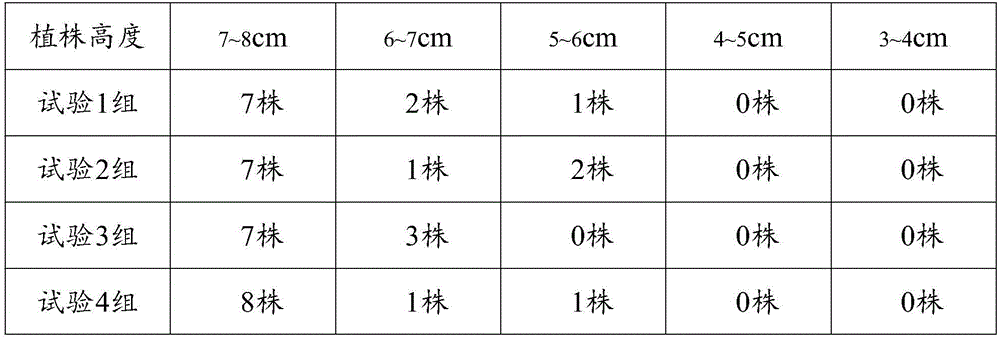Seedling culturing substrates
A technology for raising seedling substrate and amidine-based thiourea, which is applied in the field of raising seedling substrate and can solve the problems of high cost and price of substrate, unsuitable use in large quantities, rising demand and the like.
- Summary
- Abstract
- Description
- Claims
- Application Information
AI Technical Summary
Problems solved by technology
Method used
Image
Examples
Embodiment 1
[0021] A seedling raising substrate of the present invention is composed of the following components by weight: 26 parts of rice bran, 65 parts of sawdust, 19 parts of coconut bran, 3 parts of gypsum powder, 25 parts of bagasse, 65 parts of sheep manure, modified silicon 10 parts of algae earth, 30 parts of kaolin, 30 parts of chicken manure, 7 parts of amidinothiourea, and 10 parts of chloromethylpyridine.
[0022] The preparation method of above-mentioned a kind of seedling-raising matrix, comprises the steps:
[0023] (1) get the rice bran of above-mentioned weight portion, sawdust, coconut bran, bagasse, sheep dung, modified diatomite, kaolin are uniformly mixed, obtain mixture A;
[0024] (2) Get the gypsum powder and chicken manure of the above-mentioned parts by weight, mix the mixture A obtained in step (1) with gypsum powder and chicken manure, and then place them together in a fermentation tank for fermentation to obtain a fermented material for subsequent use;
[0...
Embodiment 2
[0030] A seedling raising substrate of the present invention is composed of the following components by weight: 21 parts of rice bran, 55 parts of sawdust, 15 parts of coconut bran, 1 part of gypsum powder, 10 parts of bagasse, 55 parts of sheep manure, modified silicon 9 parts of algae earth, 20 parts of kaolin, 25 parts of chicken manure, 5 parts of amidinothiourea, and 8 parts of chloromethylpyridine.
[0031] The preparation method of above-mentioned a kind of seedling-raising matrix, comprises the steps:
[0032] (1) get the rice bran of above-mentioned weight portion, sawdust, coconut bran, bagasse, sheep dung, modified diatomite, kaolin are uniformly mixed, obtain mixture A;
[0033] (2) Get the gypsum powder and chicken manure of the above-mentioned parts by weight, mix the mixture A obtained in step (1) with gypsum powder and chicken manure, and then place them together in a fermentation tank for fermentation to obtain a fermented material for subsequent use;
[0034...
Embodiment 3
[0039] A seedling raising substrate of the present invention is composed of the following components by weight: 23 parts of rice bran, 58 parts of sawdust, 18 parts of coconut bran, 2 parts of gypsum powder, 15 parts of bagasse, 58 parts of sheep manure, modified silicon 10 parts of algae earth, 25 parts of kaolin, 30 parts of chicken manure, 8 parts of amidinothiourea, and 10 parts of chloromethylpyridine.
[0040] The preparation method of above-mentioned a kind of seedling-raising matrix, comprises the steps:
[0041] (1) get the rice bran of above-mentioned weight portion, sawdust, coconut bran, bagasse, sheep dung, modified diatomite, kaolin are uniformly mixed, obtain mixture A;
[0042] (2) Get the gypsum powder and chicken manure of the above-mentioned parts by weight, mix the mixture A obtained in step (1) with gypsum powder and chicken manure, and then place them together in a fermentation tank for fermentation to obtain a fermented material for subsequent use;
[0...
PUM
 Login to View More
Login to View More Abstract
Description
Claims
Application Information
 Login to View More
Login to View More - R&D
- Intellectual Property
- Life Sciences
- Materials
- Tech Scout
- Unparalleled Data Quality
- Higher Quality Content
- 60% Fewer Hallucinations
Browse by: Latest US Patents, China's latest patents, Technical Efficacy Thesaurus, Application Domain, Technology Topic, Popular Technical Reports.
© 2025 PatSnap. All rights reserved.Legal|Privacy policy|Modern Slavery Act Transparency Statement|Sitemap|About US| Contact US: help@patsnap.com


